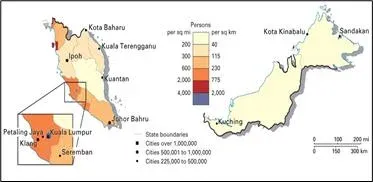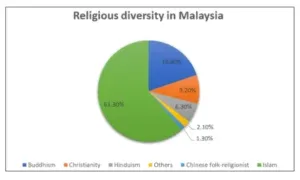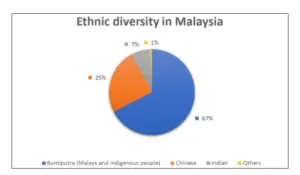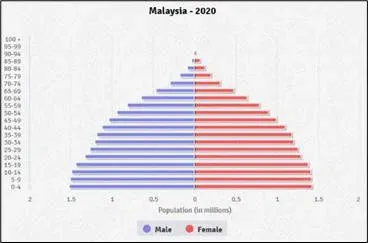Population – With a population of just over 32.7 million and a modest annual growth rate of 1.27%, Malaysia’s demographic advantage is not drawn from its abundance of people alone but rather the combination of multiple factors that augment the country’s demographic prowess. Chief among these factors is Malaysia’s labor productivity which is not only higher than the levels prevailing in India and China but is also the 3rd highest in ASEAN. As the country’s labor force continues to grow, the Malaysian economy will become increasingly attractive to foreign investors. The Labor Force as of March 2021 accounts to 16.08 million out of which 15.33 million are employed and 753.2 thousand are unemployed.
The labor force participation rate (LFPR) changed little by 0.1 percentage point to post 68.6 per cent in March 2021 (February 2021: 68.5%). Unemployment rate will fall to 4.3% in 2021. Such sturdy growth bodes well for the country in its competition against other Southeast Asian giants. The Malaysian population is spread across the country’s vast geographic expanse and may it be important to know which regions of Malaysia are most densely packed. The geographic spread of Malaysia’s population can be seen in the image below:
 Religious and ethnic diversity –Religious diversity is an undeniable characteristic of Malaysia that outlines the country’s rich cultural environment. While Malaysia does have an official state religion in Islam, the country’s constitution provides its people with the freedom to profess and practice their respective faiths. Unsurprisingly, Islam is the most practiced religion in Malaysia, with over 60% of the population belonging to this religious community. However, Buddhism and Christianity are also practiced by substantial sections of society, as exhibited in the graph below.
Religious and ethnic diversity –Religious diversity is an undeniable characteristic of Malaysia that outlines the country’s rich cultural environment. While Malaysia does have an official state religion in Islam, the country’s constitution provides its people with the freedom to profess and practice their respective faiths. Unsurprisingly, Islam is the most practiced religion in Malaysia, with over 60% of the population belonging to this religious community. However, Buddhism and Christianity are also practiced by substantial sections of society, as exhibited in the graph below.
 The Malay Peninsula and the northern coast of Borneo, both situated at the nexus of one of the major maritime trade routes of the world, have long been the meeting place of peoples from other parts of Asia. As a result, the population of Malaysia, like that of Southeast Asia as a whole, shows great ethnographic complexity. Therefore, ethnic diversity has come to be an integral component of Malaysian society with the Bumiputra, comprising Malays and indigenous peoples, standing as Malaysia’s largest ethnic group. As evidenced in the chart below, Malaysia is also home to large Indian and Chinese communities that have added to the nation’s cultural diversity and have lent credence to the phrase, “Malaysia, truly Asia.”.
The Malay Peninsula and the northern coast of Borneo, both situated at the nexus of one of the major maritime trade routes of the world, have long been the meeting place of peoples from other parts of Asia. As a result, the population of Malaysia, like that of Southeast Asia as a whole, shows great ethnographic complexity. Therefore, ethnic diversity has come to be an integral component of Malaysian society with the Bumiputra, comprising Malays and indigenous peoples, standing as Malaysia’s largest ethnic group. As evidenced in the chart below, Malaysia is also home to large Indian and Chinese communities that have added to the nation’s cultural diversity and have lent credence to the phrase, “Malaysia, truly Asia.”.
 Age – While Malaysia may currently have a fairly young population, the country is bracing itself for the prospect of an ageing population by the year 2030. The past ten years have seen a change in Malaysia’s age structure. The share of the population between 0 to 14 years has been decreasing steadily, while the inverse has been true for those aged 65 and above. The average age of the Malaysian population has reflected this trend, and is expected to reach 34 years in 2030, up from 28 years in 2015. However, as showcased in the graph below, over half of Malaysia’s population is below the age of 40, thus, presenting foreign investors with a healthy working population to be capitalized on.
Age – While Malaysia may currently have a fairly young population, the country is bracing itself for the prospect of an ageing population by the year 2030. The past ten years have seen a change in Malaysia’s age structure. The share of the population between 0 to 14 years has been decreasing steadily, while the inverse has been true for those aged 65 and above. The average age of the Malaysian population has reflected this trend, and is expected to reach 34 years in 2030, up from 28 years in 2015. However, as showcased in the graph below, over half of Malaysia’s population is below the age of 40, thus, presenting foreign investors with a healthy working population to be capitalized on.
 Literacy Rate (% of people ages 15 and above) – 95% Quality of Infrastructure Ranking – Malaysia is widely considered among the most developed economies in South East Asia and a hallmark of its development is its infrastructure. As can be seen in the chart below, Malaysia boasts a quality of infrastructure that is far higher than the levels prevailing in most other ASEAN economies, and this affords it a distinct advantage for it offers investors and companies in the country a stronger platform off which to launch growth. By ranking 35th in the Global Quality of Infrastructure Index, Malaysia has taken a step towards cementing its reputation as a leading economy in the region.
Literacy Rate (% of people ages 15 and above) – 95% Quality of Infrastructure Ranking – Malaysia is widely considered among the most developed economies in South East Asia and a hallmark of its development is its infrastructure. As can be seen in the chart below, Malaysia boasts a quality of infrastructure that is far higher than the levels prevailing in most other ASEAN economies, and this affords it a distinct advantage for it offers investors and companies in the country a stronger platform off which to launch growth. By ranking 35th in the Global Quality of Infrastructure Index, Malaysia has taken a step towards cementing its reputation as a leading economy in the region.